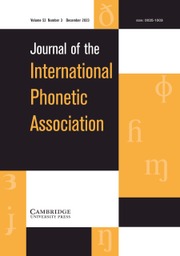Article contents
The alignment of L + H* pitch accents in Persian intonation
Published online by Cambridge University Press: 10 July 2009
Abstract
This paper investigates how the tonal targets of rises in Persian are phonetically realized in relation to the segmental string. Three types of cliticized Persian Accentual Phrases (APs) are instrumentally compared with one another: high-boundary-toned pre-nuclear APs, low-boundary-toned nuclear APs, and low-boundary-toned contrastive focus APs. The results show that the valley is always aligned with the consonant preceding the stressed vowel, but the alignment of the peak is with the consonant following the stressed vowel if the AP boundary tone is low, and with the following vowel if it is high. The duration of the focus AP is greater than that of the other two. The pitch excursion of the focus AP is significantly greater than that of the nuclear type. This difference is caused by different peak heights. While pre-nuclear and nuclear APs can be phonologically represented by L + H*, focus APs, which are pragmatically different, warrant a distinct pitch accent, namely L + ^H*. The systematic alignment of the L and the H, and the variability of the time and slope of the rise support the view that pitch targets rather than pitch movements are the fundamentals of Persian intonation.
- Type
- Research Article
- Information
- Journal of the International Phonetic Association , Volume 39 , Issue 2 , August 2009 , pp. 205 - 230
- Copyright
- Copyright © International Phonetic Association 2009
References
- 13
- Cited by


